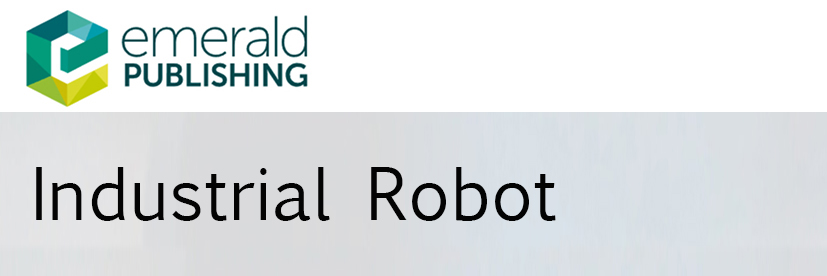ISSN (print): 0143-991X
ISSN (online): 1758-5791
Call of the Journal:
Oct
2020
The complexity of the environment and tasks that industrial robots are facing is increasing. Traditional robots based on model or human configuration cannot deploy to new environment to perform different tasks as quickly as people wants. Fortunately, vision perception can help industrial robots overcome the above problems, because most of the information related to the environment and the tasks to be performed can be input into the robot system in the form of visual information. Meanwhile, the rapid development of machine learning technology, such as deep learning, reinforcement learning, online learning, have been proved to be able to greatly improve the visual perception ability. Therefore, the learning-based vision perception can further enhance the ability of industrial robots, which enables the fast deploy and high autonomy. Although learning-based vision perception have been widely studied in related research fields, there are still many challenges when these learning-based visual perception technologies are applied in actual industrial environments, especially when robots have to work on real-time production line. First, the diversity of industrial environment requires the visual perception technology is coupled with the strong generalization ability, which is a challenge for deep learning. Secondly, it is very expensive to collect a large number of samples in the industrial environment, which also limits the application of deep learning technology. At the same time, the cost of experiments in industrial environment is also very high. The model learned by reinforcement learning can only obtained through simulator environments, and then be transferred to the actual industrial environment, which is inevitable to have large difference between two environments. Therefore, it is difficult to achieve satisfactory performance. In this special issue, we expect to publish the latest application in industrial robots about learning-based vision perception, such as the application of multimodal data for deep learning in industrial environment, reinforcement learning model that can efficiently transfer from the simulation environment to the real industrial environment, and the active learning model that can reduce the manual annotation effort. Papers submitted to this special issue should bridge the gap between industrial robots and learning-based vision perception.
Potential topics for submissions include: Sensing with deep learning, reinforcement learning, online learning, transfer learning, etc; Real-time object detection in industrial environment; Object segmentation in industrial environment; Object tracking in industrial environment; Zero/Few shot object detection and recognition in environment; Autonomous enhancement for industrial robots; Multimodal visual perception in industrial environment; Active learning in industrial environment.
Learning-based vision perception for industrial robots
The complexity of the environment and tasks that industrial robots are facing is increasing. Traditional robots based on model or human configuration cannot deploy to new environment to perform different tasks as quickly as people wants. Fortunately, vision perception can help industrial robots overcome the above problems, because most of the information related to the environment and the tasks to be performed can be input into the robot system in the form of visual information. Meanwhile, the rapid development of machine learning technology, such as deep learning, reinforcement learning, online learning, have been proved to be able to greatly improve the visual perception ability. Therefore, the learning-based vision perception can further enhance the ability of industrial robots, which enables the fast deploy and high autonomy. Although learning-based vision perception have been widely studied in related research fields, there are still many challenges when these learning-based visual perception technologies are applied in actual industrial environments, especially when robots have to work on real-time production line. First, the diversity of industrial environment requires the visual perception technology is coupled with the strong generalization ability, which is a challenge for deep learning. Secondly, it is very expensive to collect a large number of samples in the industrial environment, which also limits the application of deep learning technology. At the same time, the cost of experiments in industrial environment is also very high. The model learned by reinforcement learning can only obtained through simulator environments, and then be transferred to the actual industrial environment, which is inevitable to have large difference between two environments. Therefore, it is difficult to achieve satisfactory performance. In this special issue, we expect to publish the latest application in industrial robots about learning-based vision perception, such as the application of multimodal data for deep learning in industrial environment, reinforcement learning model that can efficiently transfer from the simulation environment to the real industrial environment, and the active learning model that can reduce the manual annotation effort. Papers submitted to this special issue should bridge the gap between industrial robots and learning-based vision perception.
Potential topics for submissions include: Sensing with deep learning, reinforcement learning, online learning, transfer learning, etc; Real-time object detection in industrial environment; Object segmentation in industrial environment; Object tracking in industrial environment; Zero/Few shot object detection and recognition in environment; Autonomous enhancement for industrial robots; Multimodal visual perception in industrial environment; Active learning in industrial environment.
Applied Science & Technology Index – EBSCO, Cabell’s Directory of Publishing Opportunities in Computer Science – Business Information Systems, Ei Compendex, Ergonomics Abstracts, INSPEC, ProQuest ABI Inform, ProQuest Engineering Collection, Abstracts in New Technologies and Engineering, ProQuest Science Journals, ProQuest Technology Collection, ProQuest Advanced Technologies & Aerospace Database, ProQuest Materials Research Database, ProQuest Materials Science Database, QUALIS, ReadCube Discover, Recent Advances in Manufacturing Databas Norwegian Register for Scientific Journals, Science Citation Index Expanded SCIE (Clarivate Analytics), Scopus.
Info at: www.emeraldgrouppublishing.com/services/authors/publish-us/publish-open-access/journal#apc-charges
Guest Editors
Prof. Shengyong Chen
Prof. Honghai Liu
Prof. Naoyuki Kubota
Dr. Jianhua Zhang









